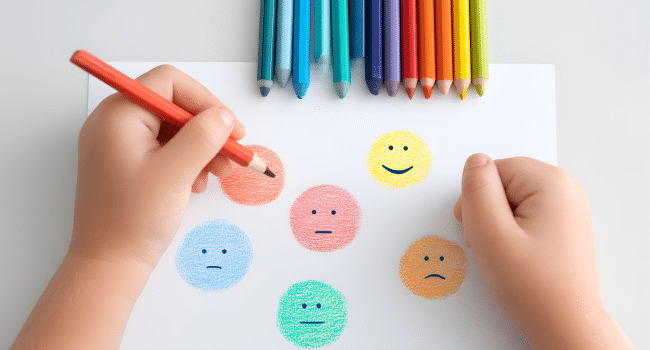Table of Contents
In today’s digital world, where children are constantly distracted by screens and fast-paced communication, the act of writing by hand presents something that is quite rare: reflection, expression, and connection. Writing is not just a hobby or something you learn in school; it’s also a way for kids to rediscover themselves and understand their emotions.
Writing classes for kids help them explore their thoughts and feelings in a structured way, while improving their linguistic and communication skills. In this blog, we’ll look at how writing by hand helps children open up and grow.
Writing Promotes Self-Reflection
Children also feel frustrated, excited, sad, and happy, but they might not always understand what these feelings are and how to express them. Writing provides them a safe and private space to work through these emotions and put them on paper.
When children perform exercises, such as writing about their day, describing one thing that makes them happy, or even coming up with creative stories, they’re actually practicing self-reflection. These exercises help them understand what they’re feeling and why, which helps them build emotional intelligence.
Over time, writing by hand helps them manage their emotions better and express themselves more clearly, both on paper and in real life. Writing is a habit that teaches them that it’s okay to slow down and take a moment to reflect inward.
Writing Gives a Secure Emotional Release
Many children find it hard to express their feelings, especially when it comes to complex emotions such as anger or sadness. Writing offers a safe, judgement-free catharsis to acknowledge and release their emotions.
In writing classes, kids are encouraged to maintain journals, write letters to themselves, or turn their feelings into enriching stories. This provides them with a way to express what they might struggle to say out loud. To them, the paper becomes almost like a close friend who listens without interruption or judgment. Such an outlet doesn’t just relieve stress but also teaches kids that their feelings are valid and worth exploring and expressing.
Writing Strengthens Communication Skills
Everybody has many ideas, thoughts, and emotions, but only a few know how to express them properly. Writing teaches kids how to turn their thoughts and ideas into clear, logical, and well-structured words and sentences.
In writing classes for kids, they learn how to structure their ideas, select words carefully, and turn them into coherent sentences. Various writing exercises sharpen their ability to organize their thoughts and turn the chaos inside their brain into calmness.
Plus, as their writing improves, so does their ability to speak clearly. Kids are able to think clearly, form compelling arguments in their head, and speak them out loud eloquently. The skills they gain from writing practice—clarity, confidence, and structure—translate into better communication and everyday conversations.
Creativity Fosters Imagination
Kids naturally have vivid imaginations. All writing classes do is give them a way to channel that creativity into stories of the animal kingdom, adventures to faraway lands, or poems about their experiences.
This kind of creative expression helps them explore their emotions. For example, a child who has a fear of the dark might write about a brave hero who overcomes his own fears, or an introvert may write about a lonely bear who finds friends. Through stories like these, kids process their feelings and make sense of the world around them.
The act of storytelling gives shape to thoughts that might otherwise be buried. It lets kids know that their ideas matter and deserve to be heard.
Writing Promotes Empathy and Compassion
Children do not simply investigate their emotions when writing; they also step into other people’s shoes. During exercises like storytelling, kids often write from the perspective of others, like a friend, a parent, or a fictional character.
This practice builds compassion and empathy. Kids begin to understand how others might feel or react in different situations. This way, writing also becomes a tool for building emotional awareness and social understanding. It shows them that everybody has emotions, and one should always respect others’ emotions and be considerate of feelings.
Conclusion
Writing isn’t just an academic skill; it’s a tool for self-expression. It helps kids understand themselves, communicate better, and connect with others. Whether through journaling, storytelling, or even essays, writing by hand allows kids to put what’s on their mind on paper without any fear or apprehension.
When supported by consistent practice and writing class for kids, this simple habit of dragging a pen across paper becomes one of the most powerful ways for kids to develop confidence, empathy, and emotional intelligence. Writing helps them grow, not just as better students, but as more thoughtful and expressive individuals.
